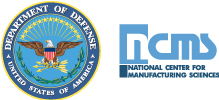065 – “DoD Equipment Reliability Improvement Through the use of Nanocomposite Coatings”
Author: Brent Barbee
Company: United Protective Technologies
Phone: (980) 233-1431
Email: bbarbee@upt-usa.com
Readiness and reliability of mechanical systems are significantly reduced by frictional losses leading to excess wear and corrosion. Performance is diminished leading to excess energy consumption and unplanned maintenance resulting in increased operational costs. Approximately 10% of energy in an internal combustion engine is lost through friction and further, in diesel engines, up to 35% of this friction loss is due to the crankshaft journal bearings alone. Similarly, the driveshaft needle bearings on unmanned aerial systems (UAS), which are widely employed throughout the Department of Defense (DoD), are a consistent source of performance failures leading to unscheduled engine overhauls.
The bulk and surface properties of nano-composite coatings (NCCs) have been engineered through individual layers, dopants and dopant profiles for a wide range of applications including engines, transmissions, and other aircraft and ground vehicle mechanical systems. The NCCs are applied in hybrid physical vapor deposition and plasma-enhanced chemical vapor deposition reactors designed and built by United Protective Technologies (UPT). The reactors have large processing volumes, which facilitate high throughput to minimize cost. A technology readiness level of 9 and a manufacturing readiness level of 10 for coatings of components such as transmission gears, needle bearings, and crankshafts have been achieved. NCCs have created a decrease in friction coefficient by more than 50% and six orders of magnitude in wear reduction for UAS engine and transmission component simulation tests.
Dramatic improvement in the performance of ring and pinion gears through both wear reduction and increased horsepower transfer to the wheels of automotive race engines has resulted from NCCs. These gears are subject to aggressive loads on the order of 1800 MPa (261 ksi). They were coated with a tungsten and carbon-based NCC specifically optimized to withstand the aggressive combination of sliding contact force and elastic deformation of the gear teeth. The gears were tested on a dynamometer at 680 flywheel HP at 8500 rpm for nine individual lap simulations after a ten-lap break-in. The significant results of the testing were an average increase of 3.5 HP over and beyond superfinishing, with a best result of 4.5 HP, and no measurable wear on three pinion teeth analyzed by profilometry. This lab data has fully translated into the highest level of America motorsports with over 90% of winning cars, on superspeedways, utilizing the proposed NCC on ring and pinion gears. These data strongly suggest that NCCs will significantly reduce wear and improve performance to mechanical systems resulting in reduced maintenance throughout the DoD. An autonomous system or piece of equipment with well-documented mechanical failures should be selected as a first demonstration of this innovative, performance enhancing technology.

